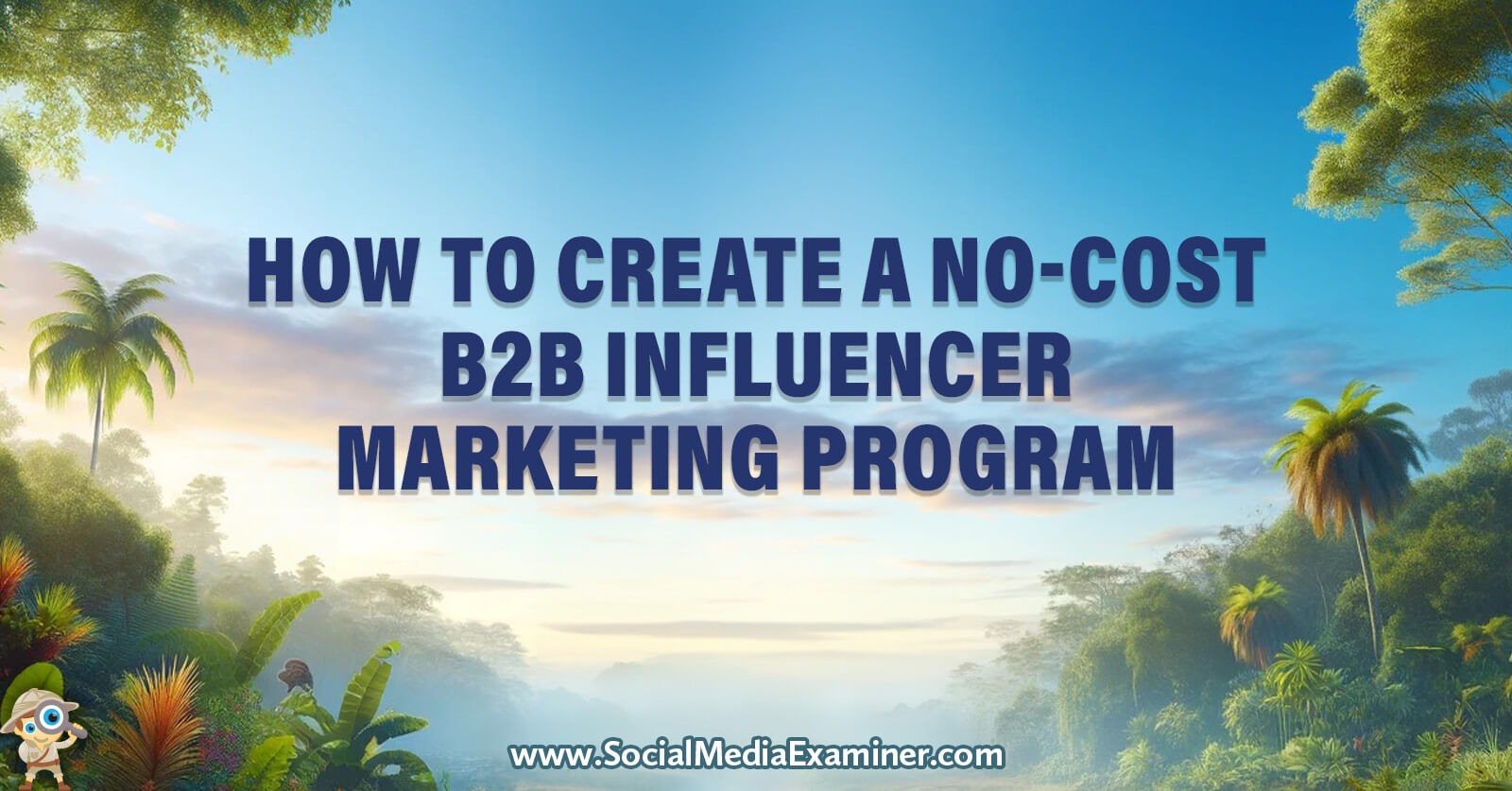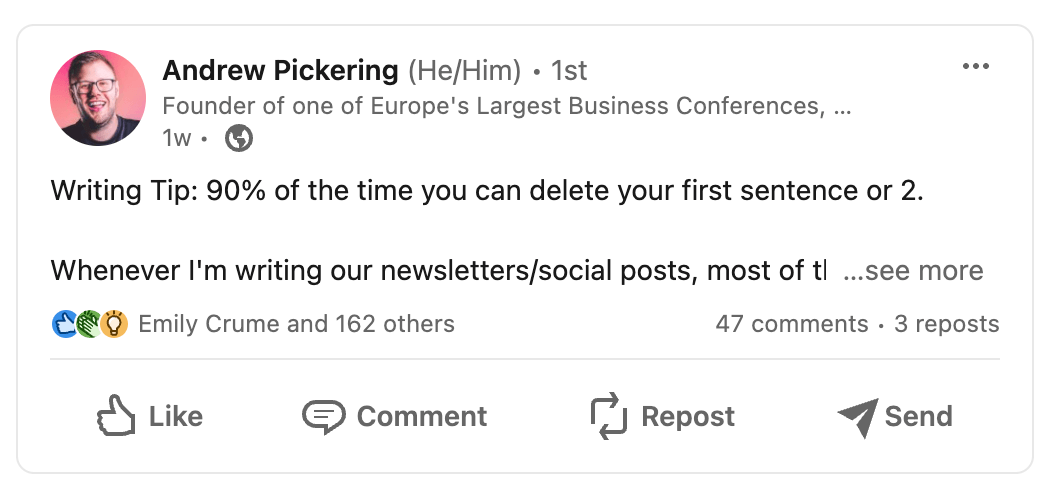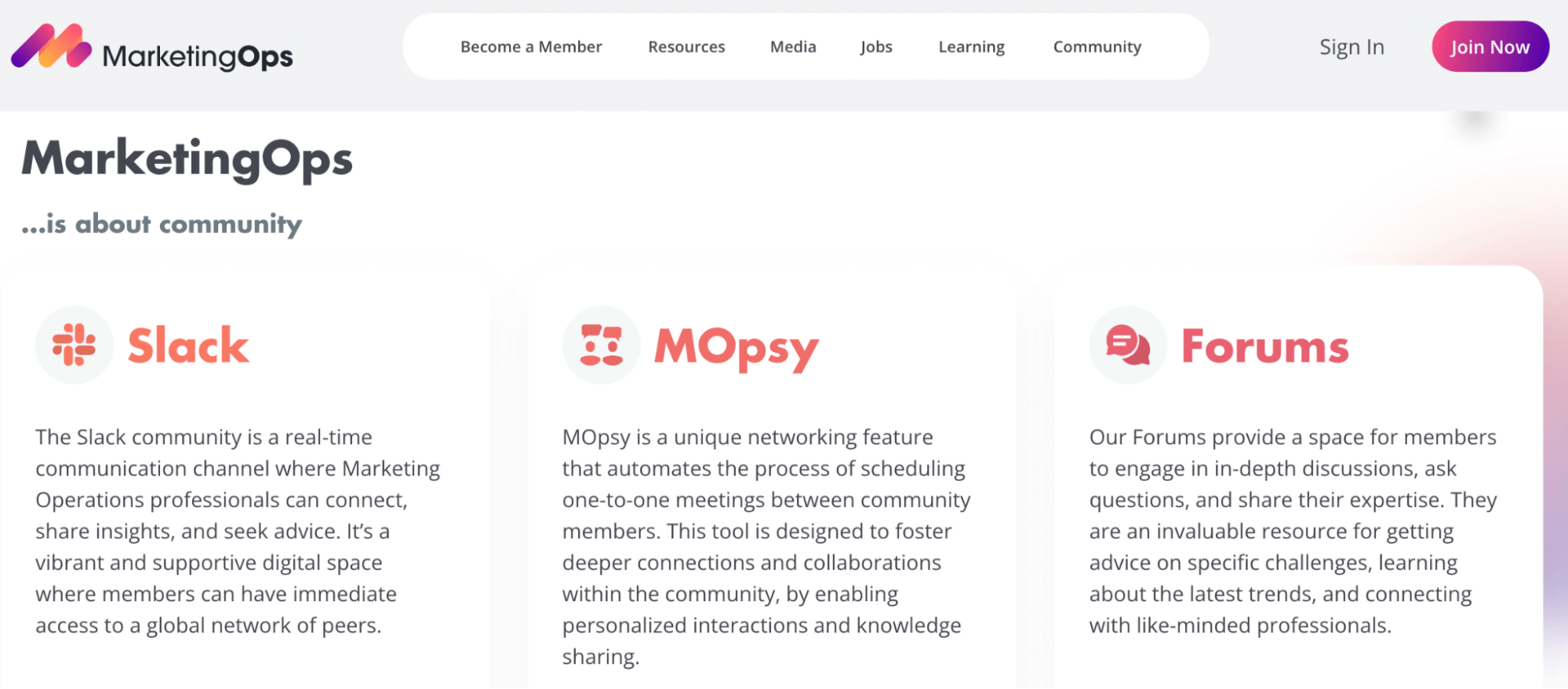Wondering how to build lasting relationships with industry influencers? Looking for a framework that doesn’t rely on a budget?
In this article, we’ll explore how to create a no-cost B2B influencer marketing program.

Why Is Influencer Marketing Important?
Influencer marketing has become an increasingly important strategy for business-to-business (B2B) brands looking to build trust, expand their reach, and engage their target audiences.
However, many companies mistakenly believe influencer marketing campaigns require a significant investment. Drawing on insights from Justin Levy, an award-winning marketer and head of social media, influencer marketing, and community at ZoomInfo, we'll explore how you can create a highly effective, no-cost B2B influencer marketing program.
Before diving into the tactical steps, it's important to understand why influencer marketing is so valuable for B2B companies. As Justin explains, people tend to trust other humans more than brands. If someone you know and follow, even within your industry, authentically shares a positive experience with a product or service, you're more likely to trust that recommendation than the brand's own digital marketing efforts.
This human-to-human trust factor is especially crucial in B2B brands, where buying groups are typically larger, and the sales cycle is longer than in business-to-consumer (B2C) companies. By engaging influencers who have already built trust with their own communities and networks, brands can tap into that credibility and those shared values to reach and persuade potential customers they may not have direct access to otherwise.
An influencer is someone who has built trust and engagement with their audience. Importantly, influencers don't need massive followings to be effective. While reach is undoubtedly a factor, engagement is even more critical.
For example, someone with 100K followers who only reposts company content may have little engagement. In comparison, someone with just 500 followers in a niche community may have high engagement on every well-crafted post. You should never overlook the power of nano- and micro-influencers with small but mighty communities.

Influencers can be Instagram creators or YouTube stars, but they can also be bloggers, podcasters, or people with engaged email lists or membership communities. For B2B brands, an influencer could be someone with a highly active Facebook group or LinkedIn presence.
Additionally, there's a misconception that certain platforms are only suitable for specific influencers. For instance, many people assume TikTok is solely for B2C influencers. However, this isn't always the case, as different creators can leverage these platforms in various ways.
Influence can also come from less visible sources. For example, someone with an extensive email list of 200K–400K subscribers, a high open rate, and strong engagement can be an influencer, even if they don't have a massive social media following.
4 Steps to Build Your No-Cost B2B Influencer Marketing Program
By following Justin’s four-step framework of research, content creation, outreach, and ongoing engagement, you can build authentic influencer relationships that expand your reach and credibility without spending a dime on expensive tools or paid sponsorships.
#1: Research: Identify the Right Influencers
The first step is researching and identifying potential influencers to feature in your B2B influencer marketing campaign. Since you're not using paid tools, this process will be manual but effective.
Start by asking your community who they find most valuable in your niche or industry. Post questions to your target audience on LinkedIn, Facebook, X/Twitter, and other social networks to gather names, and ask your followers to tell you who their favorite industry experts are in the comments.
Get World-Class Marketing Training — All Year Long!
Are you facing doubt, uncertainty, or overwhelm? The Social Media Marketing Society can help.
Each month, you’ll receive training from trusted marketing experts, covering everything from AI to organic social marketing. When you join, you’ll also get immediate access to:
- A library of 100+ marketing trainings
- A community of like-minded marketers
- Monthly online community meetups
- Relevant news and trends updates
You could say: “We're compiling a list of the top 25 demand generation people to follow in 2024. Who are your go-to people that we should feature?” Your audience will likely be happy to tag and suggest their favorite influencers. People love to recognize and uplift those they admire.
Private communities are another great way to engage with specific groups of people. For example, if you want to connect with marketing and operations professionals who have deep industry knowledge, join a free community like Marketing Ops Pros and engage with people on their Slack channel.

Finally, conduct manual searches for relevant job titles and keywords, such as “Director of Demand Generation.” On LinkedIn, focus on 1st- and 2nd-degree connections, as you'll be able to see more information about them. Look at their follower counts, title alignment with your search, post frequency, and engagement rates to start stack ranking potential influencers.
Note that if someone hasn't posted in a while (e.g., their last post was a month ago, and the previous one was five months before that), they may not be a good fit, regardless of their follower count.
At this initial research stage, aim to identify 25–35 potential influencers, whom you'll then whittle down to a shorter list later. Don't just focus on experts with the largest followings—up-and-coming voices with smaller but engaged audiences in your industry can be great partners. Focus on the relevance and value of their content and how it resonates with your brand. They'll likely be even more motivated to work with you and share your content as they build their personal brands.
#2: Content Development: Featuring Influencers
Once you have your initial list of potential influencers, the next step is to create content that features them. The best format is a blog post, which you can publish on your website. This also has search engine optimization benefits and can drive traffic back to your site.
Create a blog post featuring your top 15–25 influencers. Use an engaging title like “25 Demand Gen Leaders to Follow in 2024.” For each influencer, include their headshot, name, title, company, LinkedIn profile URL, and a brief bio (50–100 words) of why you chose them (you can adapt this from their LinkedIn “About” section).
Next, add screenshots and links to 1–2 of their best LinkedIn posts, articles, videos, or podcast episodes. These examples demonstrate their expertise and give your audience a preview of their content. Be sure to include a variety of content types and perspectives.
Then, create custom visuals for each influencer that package up the key details about them and the list you're featuring them on. These “social cards” can be easily made in Canva. They should include your company branding and the list's name (e.g., “Jane Smith, Top 25 Demand Gen Leaders to Follow in 2024, Presented by {Your Company}”). The influencers can share these eye-catching cards on social media to inform their followers about the recognition.

Discover Proven Marketing Strategies and Tips
Want to go even deeper with your marketing? Check out the Social Media Marketing Podcast! Publishing weekly since 2012, the Social Media Marketing Podcast helps you navigate the constantly changing marketing jungle, with expert interviews from marketing pros.
But don’t let the name fool you. This show is about a lot more than just social media marketing. With over 600 episodes and millions of downloads each year, this show has been a trusted source for marketers for well over a decade.
#3: Prep and Outreach: Engaging Influencers
With your blog post published and social cards ready to go, it's time to do outreach to the influencers you've featured. The goal is to get them excited about being included so they'll help spread the word and drive more visibility to your brand.
If you have the influencer's email address, send them a message with a subject line that celebrates their achievement, such as “Congratulations {First Name}, You've Been Named a Top Demand Gen Leader to Follow in 2024!”
In the email body, explain why you chose to feature them and highlight a few of the other incredible influencers or brands on the list. Make them feel special! Include a pre-written social media post with their social card and a link to your blog post they can share, something like: “I'm excited to be named a Top 25 Demand Gen Leader to Follow in 2024, along with other industry leaders like @otherexpert and @coolperson. Check out the full list: {link} #demandgen”.
Here’s another example of outreach: Justin partnered with LinkedIn's Women in Sales group for two consecutive years. They created a list called the “100 Powerful Women in Sales.” First, they researched and identified 100 women to include in the list. Then, they created a blog post featuring all 100 women, which was 10,000 words long. After publishing the blog post, they reached out to all 100 women. They directly contacted those they had emails for. For those who didn't have emails, Justin reached out privately on LinkedIn.
If you don't have an influencer’s email address, you can send them a friendly LinkedIn message explaining the good news and asking for the best email to reach them. Most people are willing to engage when you reach out to them on LinkedIn. In Justin’s experience, only about 5–10% never respond. The people who don't respond are usually more well-known individuals with whom you're not yet connected or who have someone else managing their accounts.
Don't be surprised if your outreach gets enthusiastic responses! Many people deeply appreciate this type of recognition and will be excited to share the good news with their networks.
Justin has found that people often update their profile headline to include this recognition. Instead of simply stating their job title, like “Founder of {Company},” they'll add “Featured in 100 Most Powerful Women” or something similar. This is because being included in such a list serves as a validation for them and their work. It feels like winning an award and showcasing this achievement is good for their brand credibility on the platform.
#4: Measuring Ongoing Engagement and Deepening Influencer Relationships
As your influencer partners help spread the word about your list, keep an eye on key performance metrics like overall reach and engagement (likes, comments, shares), traffic back to your site, and the number of influencers who posted about being featured.
Getting an initial burst of visibility is great, but don't stop there. To get the most value from influencer partnerships, look for creative ways to collaborate with your influencers and help them build their authority and personal brands. As these relationships deepen, some influencers may help promote your company's events, products, or offerings.
When reaching out to people, it is essential to focus on building long-term relationships rather than just having short-term, transactional interactions. Transactional here doesn't mean involving money but rather refers to a one-time outreach without any follow-up or effort to deepen the connection. Always aim to build long-term relationships that provide ongoing value to both parties.
Here are five ideas to get you started:
- Comment on and share their content.
- Introduce them to each other.
- Invite them to contribute a quote to an eBook, be a guest on your podcast, or write for your blog.
- Profile a different influencer each month in your email newsletter.
- You can also ask your influencer community for their predictions on industry trends or timely responses to breaking news and use their quotes to create more roundup content.
Let’s say you’re writing an eBook and want to include contributions from some of your influencers. Follow up with the people you contacted and ask them a simple question about their expertise or experience. Keep it low effort on their part. For example, if it's a sales list, you could ask, “Hi Jane, congrats again! We're making an eBook. I would love your contribution to this. Can you send me a couple of lines about how the pandemic impacted your sales?”
Collect the responses and use them to create your eBook. Organize the content based on the responses you receive. Then, start the process again:
- Create new social media cards featuring quotes from the contributors.
- Reach out to the contributors again, sharing their quote cards and a link to the ungated eBook landing page.
This process deepens your relationship with the contributors by featuring them again and benefits your brand. You'll gain additional social exposure as the contributors share their involvement in the eBook, just as they did when you included them in your “Top 25” list.
Over time, some of these influencer relationships that started with a simple mention on a list could turn into ongoing brand partnerships, referral sources, or even customers.
Influencer marketing strategy is all about building real human connections. By leading with generosity and focusing on spotlighting individuals who are already creating great work in your industry, you can form authentic partnerships that boost your brand's credibility, reach, and engagement—all without spending a dime on paid partnerships or tools.
Justin Levy is an award-winning marketer and head of social media, influencer marketing, and community at ZoomInfo, a software company that provides a data platform for businesses and individuals. He has over 15 years of expertise in corporate social media, influencer marketing, content creation, and community building for companies such as Demandbase, ServiceNow, and Citrix. You can find him on LinkedIn and Instagram.
Other Notes From This Episode
- Connect with Michael Stelzner @Stelzner on Instagram and @Mike_Stelzner on Twitter.
- Watch this interview and other exclusive content from Social Media Examiner on YouTube.
Listen to the Podcast Now
This article is sourced from the Social Media Marketing Podcast, a top marketing podcast. Listen or subscribe below.
Where to subscribe: Apple Podcasts | Spotify | YouTube Music | YouTube | Amazon Music | RSS
✋🏽 If you enjoyed this episode of the Social Media Marketing podcast, please head over to Apple Podcasts, leave a rating, write a review, and subscribe.
Stay Up-to-Date: Get New Marketing Articles Delivered to You!
Don't miss out on upcoming social media marketing insights and strategies! Sign up to receive notifications when we publish new articles on Social Media Examiner. Our expertly crafted content will help you stay ahead of the curve and drive results for your business. Click the link below to sign up now and receive our annual report!
Attention Agency Owners, Brand Marketers, and Consultants

Introducing the Marketing Agency Show–our newest podcast designed to explore the struggles of agency marketers.
Join show host and agency owner, Brooke Sellas, as she interviews agency marketers and digs deep into their biggest challenges. Explore topics like navigating rough economic times, leveraging AI, service diversification, client acquisition, and much more.
Just pull up your favorite podcast app, search for Marketing Agency Show and start listening. Or click the button below for more information.

